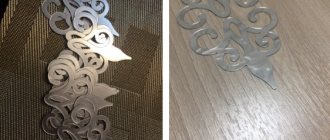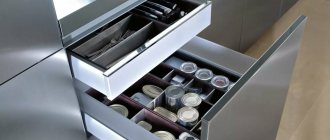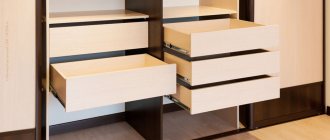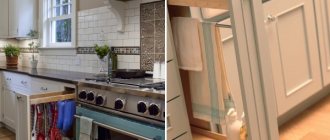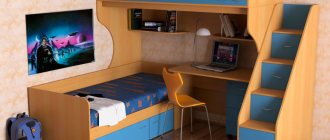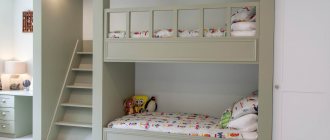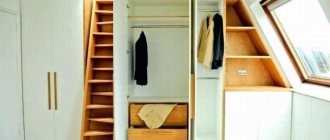Homemade security features
You can make devices that prevent doors and cabinets from opening with your own hands; for this you need to use your imagination.
Parents seal cabinets with duct tape or put rubber bands on handles, and hide the extension cord in a cardboard box. If you make furniture protective devices yourself, make sure they are reliable before use.
Option for homemade protection from corners of furniture using polyurethane pipe and tape:
Homemade protection option for drawers:
Locking devices for drawers
The most popular method of protection is special latches, one part of which is attached to the furniture frame using special Velcro, and the second half is attached to the front of the drawer. Such protective devices can be purchased in specialized children's stores. They are inexpensive, and not much time is spent on their installation. When the need for such latches passes, they can be easily removed, and not a trace will remain of them on the furniture.
It is possible to install handles on furniture or, for example, on windows with a special built-in lock. But this method is a little more complicated than described above, since you will need to find handles that would fit in place of the handles installed on the furniture. After you have bought such a handle, it is installed on the drawer, and it is simply locked.
Anti-tip system for furniture and equipment
We protect young climbers who are determined to conquer furniture Everests with the help of special fittings or steel corners - they will prevent heavy furniture from tipping over if the child hangs on a wardrobe door or climbs into an unlocked dresser drawer.
Depending on the modification of the anti-tip system, as well as on the manufacturer, the cost of the device will range from 200 to 400 rubles .
Attention! It is better to choose an “anti-tip” system equipped with a belt that holds the furniture - if necessary, in order to move the furniture away during cleaning and then secure it again, you will only need to unfasten and fasten the belt.
Types of children's blockers
For windows
They do not allow the frame to be opened or inform the parent with a loud sound that the window has opened. You should choose them taking into account the type of window: rising, sliding, opening inward or outward.
Flexible devices
There is also a universal type of device; they cover windows, any cabinets and a refrigerator. They are made of flexible material and are attached using an adhesive base at a height that a tomboy definitely cannot reach.
For drawers
The lock will prevent the drawer from being pulled out, protecting children from the drawer falling on their feet when opened abruptly. Such devices are secured with small screws from the inside.
Using such locks live:
But such protection does not always work - the test drive from the girl Yana failed...
Corner clamps
They are used for various cabinets, they are attached to the side and do not allow the door to be opened, they are often made of plastic, but are reliable.
For toilet lid
Children love to wash their hands in the toilet and throw toys in it, but they will not be able to open the lid, which is secured with a toilet lid lock.
For doors
There are two types: some fix the door in a certain position, while others do not allow it to be closed completely. The second type is in great demand, as soft shock absorbers allow you to use the door as safely as possible.
Plugs for sockets
Thanks to this plug, the baby will not be able to put anything into the socket.
They can be made of plastic or rubber.
Review of protective devices from a wise dad:
Instructions for locking cabinets and cabinets from children:
- If the furniture is equipped with locks, then it is necessary to close all doors with keys, and then put them out of the reach of children.
- Hinged cabinet doors can be closed by tying adjacent handles together with rope. To do this, the rope is passed between the handles in the shape of a figure eight and tied in a knot. This method is suitable for shelves that are used on rare occasions.
- For doors and drawers that have to be used frequently, special protective devices purchased in children's and hardware stores are suitable. A locking lock is an easy-to-use and inexpensive mechanism that is designed for different types of doors. Using these locks, you can easily lock sliding, folding and swing doors with close adjacent handles. They are produced in various versions. For example, to lock swing doors, use U- and C-shaped locks and locking rings for cabinet handles. After dismantling, they do not leave any marks on the surface of the furniture.
- It is convenient to glue soft locks to sliding and glass surfaces without handles. Thanks to the adhesive surface of the clamps, they are easy to dismantle, because they do not leave marks on the furniture. The disadvantage of soft locks is that a child can learn to open them on their own, but this can be overcome by gluing the locks higher. In addition, these universal locks are used on the surface of the refrigerator, microwave oven, toilet lid and even on windows.
- The latches will help prevent the drawer from falling out on your feet. They are attached from the inside with screws or Velcro on the side from the outside. The side latch can only be opened by pressing the buttons simultaneously while pulling the drawer towards you.
There are many manufacturers of home security devices. The most popular are the following:
- Mothercare (UK);
- World of Childhood (Russia);
- Canpol (Poland);
- Chicco, Poupy, Brevi (Italy);
- Safety First (Netherlands);
- Baby Dan (Denmark);
- Bebe Confort (France);
- IKEA (Sweden).
Products of Polish and Russian brands have an affordable price, which can be 5-7 times lower than that of brands from European manufacturers, while the quality of their products is also at the same high level.
Even if you consider all these protective devices to be a whim of inventors, you will still have to come up with something at the moment when the baby learns to crawl. After all, literally everything falls into his field of vision - from a boiling kettle on the stove to a mosquito net on the windows. So, various protections are not a whim, but a necessity for those conscious parents who do not want to remember the first couple of years of the baby’s life as time spent in traumatology.
The danger of basic household items cannot be underestimated - burns, falls, bruises and fractures are possible, because the child does not know how to properly handle the familiar objects around us.
Safety for children at home: door lock
Some parents buy a playpen and believe that their baby is safe in a limited space. But the baby’s desire to explore everything is very strong, and as long as you rely on the walls of the playpen, he will successfully overcome the first obstacle in his life - and start exploring electrical sockets or pull the laptop standing on the table by the wire. Fortunately, today literally everything can be made safe - you only need devices specially designed for this.
Door plugs
For a small child, the entire apartment is one continuous threat. And even such a seemingly harmless thing as a door carries a danger for him: a baby can, while holding onto the door, accidentally close it and get his fingers pinched.
Protection for interior doors also comes in different configurations, but the essence is the same - to prevent the door from closing. This can be a small prop that fits under the door, or a large, U-shaped rubber pad that fits anywhere on the door to prevent it from closing.
So, buying childproof furniture today is not a whim, but a necessity caused by the activity and curiosity of a rapidly developing baby. Remember: a pinched finger is the most harmless thing that can happen if you don’t take care of your baby’s safety.
Inspire us - share the material with your friends on social networks:
Read with this article:
Defense Mechanisms
The simplest devices for locking cabinet doors and cabinets can be made with your own hands. Our mothers and grandmothers used such simple methods using improvised means. Two adjacent door handles can be tied with a strong thick thread, rope or elastic band.
The disadvantage of this method is that the baby may well, over time, master the method of getting rid of such a “lock” and, with his own hands, open up access to the hidden depths of the furniture shelves. In addition, this is inconvenient for adults themselves, because the rope or elastic band will have to be removed every time you need to take something from the closet, and then re-attached to the handle.
Drawers or wardrobe doors can be blocked by gluing a strip of wide adhesive tape or insulating tape to their sliding surface. The disadvantages of this method are the same as those described above. In addition, the tape will leave sticky marks that are difficult to remove on furniture surfaces. You can curtain a chest of drawers or a cabinet with a large blanket or tablecloth.
The child will most likely see only a solid piece of matter and move on to more interesting things. This method is only suitable for very small and unintelligent children. It can be used as a temporary measure until more secure locking devices can be installed as soon as possible.
Sometimes furniture doors or drawers are equipped with mortise locks. Basically, such locks were often found in old furniture. In this case, you just need to find the key and do not forget to close the lock on the furniture with it after each use. Keep keys to cabinets and shelves out of the reach of small children. And of course, it is very undesirable to forget the storage location or lose the treasured key. In this case, taking the necessary items from bedside tables and chests of drawers will no longer be possible for an adult. However, modern furniture manufacturers do not often embed locks into drawers and doors.
If possible, it is better to take care of such furniture in advance by choosing the appropriate model or having it made to special order. It is not entirely advisable to embed such locks into existing furniture. The difficulty is choosing the lock itself.
Correct installation of a child lock
Installation of the device does not require much time, effort or special training. An adult, knowing the instructions, can install the product independently. The installation technology is as follows:
- The first step is to disinfect the surface where it will be installed.
- If the blocker is based on glue and purchased when it is cold outside, then it should be given time to warm up at room temperature. When cold Velcro is applied, it does not attach well, sticks, and the stopper will not work well.
- To speed up the process, you can warm up the attachment point with a hairdryer.
- Next, remove the protective paper from the patch.
- The blocker is attached tightly closed to the desired location.
- When the design of the lock requires fastening with screws, you need to use a screwdriver to screw them into the places where the lock is installed. The mechanism can be opened and unlocked by simultaneously pressing buttons on both sides.
- To ensure the safety of children, wardrobes are often equipped with a top mortise latch.
- Sliding locks of the C- and I-shaped design are attached to swing doors, where the handles on the doors are located nearby - at a distance of 2.5-21.5 cm. To open it, you need to unfasten the latch on one side of the lock.
The locking lock has become popular in many countries. For young child researchers, the blocker has become an insurmountable obstacle, and for parents it is a guarantee of peace of mind and confidence that the child is safe.
Safety of children in the home:
Voted over 294 times, average rating 4.4
Comments
Unfortunately, there are no comments or reviews yet, but you can leave your...
Add a comment Cancel reply
We recommend reading
Locks, Accessories Characteristics of overhead door handles not associated with the lock mechanism The choice of door handles is wide. Models are divided by type of work into...
Locks, Accessories A simple scheme for creating a combination lock for entrance doors with your own hands. The entrance door is installed so that strangers and unwanted ...
Locks, Fittings Description, purpose and installation of the strike plate for a door lock Regardless of the cost and quality of the door, maintain good condition...
Locks, Accessories We reveal the intricacies of opening a combination lock. Sometimes when entering a combination of numbers, the combination lock can...
Are they really necessary?
Many parents have become convinced of the convenience and safety of using locking devices for furniture doors and drawers. When there is a little explorer in the house, you should not skimp on safety measures. Moreover, manufacturers provide a very wide range of locks and locks for cabinet doors and drawers.
In addition to the fact that such devices and mechanisms protect the baby from injuries and dangers associated with heavy or sharp objects, chemicals from cabinet shelves, they also relieve parents from forced cleaning. While exploring the spaces of a chest of drawers or drawers, the baby often leaves behind a decent mess.
Parents of especially active and inquisitive little ones have to put things in order and do cleaning several times a day. Before mom has time to sort out the clothes thrown out of the drawer, the sound of tubes of cream and bottles of eau de toilette falling to the floor, or even the sound of a broken cup, can already be heard from the next room.
Scolding a child for his natural interest in his surroundings is almost the same as scolding a person for wanting to sleep or eat. The development of intelligence and physical functions is inextricably linked with the practical study of the world. The baby actively moves, looks at, touches objects, and drags them into his mouth. He does this not at all out of conscious mischief, and not out of a desire to deliberately annoy you. Remember this. Do not limit the child in his natural development by making scandals and scolding him for sloppiness.
Although it’s a rare mother who manages to contain her anger and irritation after yet another misstep by the fidget. The baby does not have the skills to carefully handle objects, but he will learn just this and much more throughout the first months and years of his life. You can make this process mutually enjoyable, interesting and safe enough for your child only with the protective help of parents.
For an overview of child safety locks on drawers in action, see below.
Closing the closet from the child
Hinged cabinet doors are also better protected from children. Otherwise, leaving him alone for a minute, you risk returning to the room to find a pile of linen from the lower shelves and your little one happily frolicking with him. As a rule, U-shaped latches are installed on swing doors.
This is the simplest method of protection, since it does not require drilling holes in the furniture, or even gluing the protection to the surface of the furniture.
You can also use latches in the form of plastic hooks. They consist of two parts: the first part is attached to one cabinet door, and the other - the hook itself - is installed on the other door. When the doors are closed, the cabinet is locked with a hook.
The closet door can also be locked. A mirror on a wardrobe is a very attractive item for a baby. Usually, small children enthusiastically roll closet doors, look at their reflection in the mirror, and drag all the things from the lower shelves to the floor.
Of course, devices that are installed on hinged cabinets are not suitable for sliding wardrobes. But still, today there is protection for such furniture. The most popular type of security for sliding wardrobes is the butterfly latch. It is installed on one of the doors, next to the second door. When the “wings” are lowered, the cabinet door is in a movable state. By pressing a special button, the “butterfly wings” rise and prevent the cabinet door from rolling.
Interlock locks
As for the furniture itself, its design should not raise doubts about its stability; there should be no sharp corners. Shaky furniture should be strengthened or moved to another room where the baby has no access. The task of parents is to protect their child from possible bruises, and themselves from unwanted disorder.
All parents know how dangerous it is to play with the closet door. To prevent your child from accidentally pinching his fingers or using prohibited items for play, you can use special devices. These are so-called blocking locks.
They differ depending on the types of doors:
For door wardrobes and sliding wardrobes. Universal models are designed for two types of doors. The device looks like two button-shaped clips that are glued to the cabinet: there are models with an adhesive base or with suction cups. They are connected to each other with an elastic plastic tape.
For swing doors. This option differs in the need to use screws. Such products are suitable for wooden furniture. One part of the blocker is screwed from the inside to the door, the other to the top wall. Swing doors are also locked using U- and C-shaped locks and rings that fit onto the cabinet handles.
For glass. Some cabinets have fragile transparent doors, and they arouse special interest from children: after all, through glass everything seems even more tempting. Locks in the form of hook-locks are specially made for glass doors.
Special handles with built-in locks and latches are very convenient. They can be placed in the same place where the old handles were. This is very convenient: you will not need to make an additional hole in the furniture. The disadvantage of such a handle with a lock is the higher price
(compared to other blockers).
The need to protect furniture
A small child finds everything that happens around him interesting, so situations often arise that threaten the baby’s health. The time when children begin to crawl and walk is considered especially dangerous, since the danger will be from sharp corners and doors of furniture, sockets, and household appliances. Young children especially actively begin to explore the world from the contents of the closet and shelves. Some things can be removed or moved higher, but the sharp corners of tables, sofas, chairs, and drawers remain.
To reduce the risk of injury to a child, caring parents resort to tricks - installing protection, limiters and blockers. Sometimes such devices are made independently, but a more reliable option is special products that can be purchased at hardware stores.
Types and models of blockers
Locking locks are designed for hinged sashes and doors. Depending on the type of handles on the doors, they come in different shapes. These locks are very easy and quick to install on cabinet handles and securely hold the doors in the closed position. Door locks of this type look neat and will not damage your furniture. They do not tear or stretch when opened and closed multiple times, and are quite strong and durable.
For sliding doors and drawers in a chest of drawers or cabinets, soft Velcro locks are suitable. They are attached to the side and front surfaces of the furniture and connected with a special fastener, thereby keeping the drawer from sliding out. Depending on the model, the locking mechanisms may be different: special hidden buttons, hooks and ears. Locks of this type can also be used to lock the doors of kitchen appliances that are dangerous for children (refrigerator, microwave oven, oven). After all, the baby is unlikely to limit his travels to the living room and his children's room.
To protect the child from a heavy box falling on his feet, you can attach special latches that block the extension. Even if a young fidget somehow manages the lock blocking the drawer, the latch will work when pulled out and will not allow the drawer to be pulled out of the cabinet too far. Such devices are attached to the inside of the furniture and block the movement of the drawer to a certain amplitude. Fastening is carried out either using bolts or using holders glued to the inner surface of the box
More expensive models of locks and security devices are often equipped with a special built-in sensor that emits an audible signal when an attempt is made to open incorrectly (pulling the handle while the lock is closed or applying force to the mechanism itself). The intensity and type of sound signal can be adjusted through the settings. For vigilant parents, this is undoubtedly a significant advantage.
(no votes yet)
Types of locks
Different locks differ from each other not only in appearance, but also in purpose, type of fastening, and material.
- Velcro. Designed for external mounting. They are a strap made of plastic, fabric or silicone, which is attached to clamps on both sides. For installation they are equipped with an adhesive surface, suction cups or tape.
- Internal type. More reliable. It has a different base for fastening. Stoppers prevent drawers from opening. Made from durable plastic. Their undeniable advantages: invisibility, minimal damage to the appearance of the furniture.
- U-shaped device. Acts as a child lock. The U-shaped structure is placed on the door handles, and the free edges are secured with a special lock. The plastic used in production is very durable.
- C-lock. The operating principle is similar to the U-shaped one, but consists of two parts, which are held together by a reliable mechanism.
Velcro
- Price from 160 rubles.
- A flexible lock made of durable plastic; the strap is securely attached to buttons hidden under the cover of the round fasteners. The set includes 2 locks in pink or blue. Attaches with double-sided tape.
- Pros: made of high-quality materials, glue residues are easily removed, the blocker is easy to attach to furniture, the price corresponds to the quality.
- Disadvantages: over time, the strap begins to not hold so firmly on the latch.
- Price from 280 rubles.
- Consists of two suction cups onto which a plastic strap is attached. Clippasafe products are manufactured in the UK and are of high quality.
- Pros: easy to attach to any surface, suction cups leave no marks, plastic strap is strong and durable.
- Cons: high cost, using the lock is not very convenient - the strap is difficult to remove from the suction cup.
To secure inside
Munchkin Drawer Lock:
- Price from 590 rubles.
- A set of four plastic locks that are attached to screws from the inside of the cabinet. When closing, special hooks fit into the grooves of the device; to open the cabinet, you need to squeeze the lock on both sides. For a small child this task is impossible.
- Pros: safe design, parts made of high-quality materials, screws securely fasten the blocker to any surface.
- Cons: installation is carried out using screws and leaves holes in the furniture.
Safe&Care magnetic lock:
- Price from 920 rubles.
- Plastic lock with magnetic mechanism. The lock is attached to the drawer with a screw or double-sided tape, and a special hook prevents the door from opening. To lower the hook, you need to bring the magnetic key to the device. Includes 2 locks and 1 key.
- Pros: when fixed with tape, the lock will not leave marks on the furniture, the child will not open the cabinet and pinch his fingers, the lock will last for many years.
- Cons: the device is expensive and not sold everywhere, suitable for cabinets no more than 3 cm thick.
